Table of Contents
High-volume, low-pressure water jets have been employed for erosion of loosely consolidated rocks for centuries. This excavation method finds application in specialized circumstances even today. The use of high-pressure, low-volume water jets for rock cutting is more recent and was made possible by the development of high-pressure water pumps. Despite the benefits often claimed for these systems, high-pressure water jets still have not found widespread application. In this report, the U.S. Bureau of Mines has reviewed the various methods that have been employed using water jets to break rock and has focused on one method, termed “jet-assisted cutting,” which was determined to be the closest to commercial development. The current state of knowledge based on laboratory and field experiences using this cutting method is reviewed, and possible future developments for this approach to excavation are assessed.
The most straightforward approach is to use the high-pressure water jets, in the range of 2,000 to 50,000 psi (13.8 to 344.7 MPa), to erode the entire rock face that is to be machined. This was the approach adopted by many early workers in water-jet cutting. It was discovered quickly that the efficiency with which these jets remove rock is much lower, sometimes two orders of magnitude lower, than more conventional methods, such as mechanical tools, because this water-jet technique requires impractical quantities of energy to excavate large quantities of rock, such as a tunnel face. However, considerable work was carried out developing small-diameter water-jet drills and slotting devices for cutting deep kerfs in quarries for monument stone. Some work in this area continues, although it has been found that the water-jet device suffers from the serious problem that on occasion, perhaps infrequently, it will encounter a pebble, a boulder, or a hard layer of strata that cannot easily be eroded by the jet system and which halts the excavation process. This performance is unacceptable.
Various methods have been developed to improve the efficiency of the erosion process using water jets. One of these methods involves introducing cavitation bubbles into the jet stream. If these bubbles collapse on the rock surface, the rate of rock erosion is greatly enhanced. Another method is to break up the continuous jet into packets of water that impact the rock surface. The stresses generated by this impacting action generally are much greater than the stagnation pressure of a continuous jet, and thus the rate of erosion is again enhanced. Both of these approaches have been examined by workers for some time. Each of these methods has its own problems, but both have application in particular circumstances. Another approach, developed during the past 5 years or so, shows considerable promise. In this approach, abrasive particles are introduced into the water-jet stream. The particles are accelerated close to the velocity of the jet, and it has been shown that these particles greatly enhance the erosive power of the jet.
Two other methods use high-pressure water jets in combination with mechanical tools to effect rock destruction. One of these methods employs an array of water jets to erode a series of, generally parallel, kerfs in the rock face. The mechanical tools are then used to remove the ridges of rock left between these kerfs. The presence of the kerfs substantially reduces the force that the tools are required to exert on the rock to effect rock breakage. Although, in this approach, the water jets are used to remove only a small fraction (perhaps only a few percent) of the total rock volume excavated, because of the inefficiency of this method of breakage, the ratio of the water-jet power to the power applied to the mechanical tools is high, often 4:1 to 10:1. This low fraction of mechanical power has caused this breakage method to be termed “mechanically assisted rock cutting.”
A second approach to using water jets with mechanical tools is termed “jet-assisted cutting.” Rather than employing water jets to erode a rock face directly, this cutting method utilizes these jets to erode crushed rock debris formed by mechanical tools during the rock cutting process (fig. 1). The goal in any mechanical rock-cutting operation is for the tool to induce fractures in the rock to form discrete rock chips. Unfortunately, in the process of initiating and propagating these fractures, all mechanical tools produce regions of crushed rock immediately beneath and adjacent to the tool. The stresses induced in the rock by the tool are reduced by the cushioning action of this crushed material. This increases the stress that must be induced in the tool to form a rock chip. A mechanism that has been proposed, and which is widely accepted, to explain why water jets used in this manner are effective in reducing tool forces is that the jets continuously flush this crushed material away from the tool during the cutting process.
Discussion of Jet-Assisted Cutting
For this cutting method to be effective, the jets must be directed accurately into the zone where the crushed rock is being formed. This means that the jets must be directed immediately adjacent to the cutting tools. Furthermore, the jets must be sufficiently energetic to erode this compacted crushed material. In addition to removing the crushed rock, it has been suggested that the jets assist the rock breakage process by helping to propagate the fractures that create the major rock chips (fig. 1). These fractures are initiated by the tool in the region where the water jets are directed; consequently, it is almost inevitable that water will enter these cracks. Basic fracture mechanics principles tell us that the amount of external energy required to propagate a crack is reduced by the pressure energy applied internally within the crack. Thus, if crack propagation is assisted by the action of the water jets, one would expect that the tool force necessary to drive the cracks would be reduced.
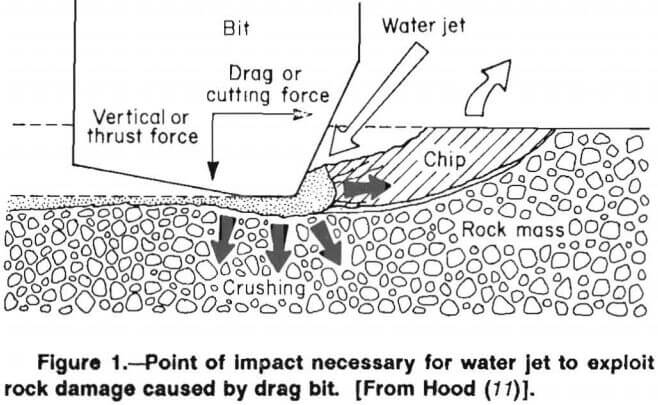
Hood conducted a series of quasistatic load tests to ascertain whether this crack drivage behavior was actually observed. He showed that the tool force necessary to form a rock chip was indeed reduced when water jets were directed adjacent to the tool during the loading process. However, in a later paper Tutluoglu demonstrated that the energy required to form the large rock chips created during the cutting process is only a very small fraction (less than 5 pct) of the energy applied to the tool. Hence, the author argued that although the jets do assist with crack propagation, this process cannot account for the observed dramatic reductions in the tool forces (and therefore in the input energy to the tool), and these force reductions can exceed 50 pct. Tutluoglu argued that the principal action of the jets in reducing tool forces must be one of crushed rock removal from the region adjacent to the tool. A similar conclusion was drawn by Fenn.
The term “jet-assisted cutting” comes from the fact that the principal source of energy for the rock breaking operation is provided by mechanical tools. The energy from the water jets supplements, or assists, this breakage process. It is apparent that this contrasts with mechanically assisted cutting in which the water-jet energy is the principal energy source for the breaking operation.
The benefits of jet-assisted cutting remain controversial. Several research workers claim the following substantial benefits for this cutting method: (1) Reductions in cutting tool forces, (2) improvements in tool life, (3) reductions in the dust generated during the cutting process, (4) reductions in the incidence of frictional sparking in gassy environments, and (5) reductions in vibration of the cutting machine. Other workers accept that all of these benefits can be obtained under laboratory conditions, but they claim that in practical mining and tunneling situations, many of these benefits cannot be reproduced.
In large part this controversy seems to have developed because the benefits of jet-assisted cutting are influenced by a large number of factors, including the rock type, the depth of cut taken by the tool, the cutting velocity of the tool, the tool geometry, the number of water jets used to assist each tool, the position of the jet(s) with respect to the tool, the jet pressure, and the jet flow rate. Studies conducted by the various research workers have examined some aspect of the problem, but to date, no unifying mechanistic theory of this cutting process has emerged to reconcile apparently contradictory findings by different research groups. In this report, the researchers have attempted to summarize these findings in a manner that conveys, hopefully, the current state of knowledge in this field.
Laboratory & Field Experiences
Drag Bit Force Reductions-General
Jet-assisted cutting was developed originally to solve a problem of excessive tool wear that had been experienced in an experimental program to machine strong, abrasive quartzites in South African gold mines. During the course of this program, it was discovered that a high-volume, low- pressure water jet directed at the rock-tool interface not only cooled the cutting tool—a drag bit—but it also reduced the peak forces experienced by the tool during the cutting operation. Following this discovery, detailed experiments were undertaken to determine the extent to which the bit forces might be reduced by using water jets at higher jet pressures. In these tests, Hood showed that the mean bit forces, as well as the peak forces, could be reduced consistently by a factor of 2 or more using moderate- pressure, about 5,800-psi (40-MPa), water jets directed immediately ahead of the bit during the cutting process.
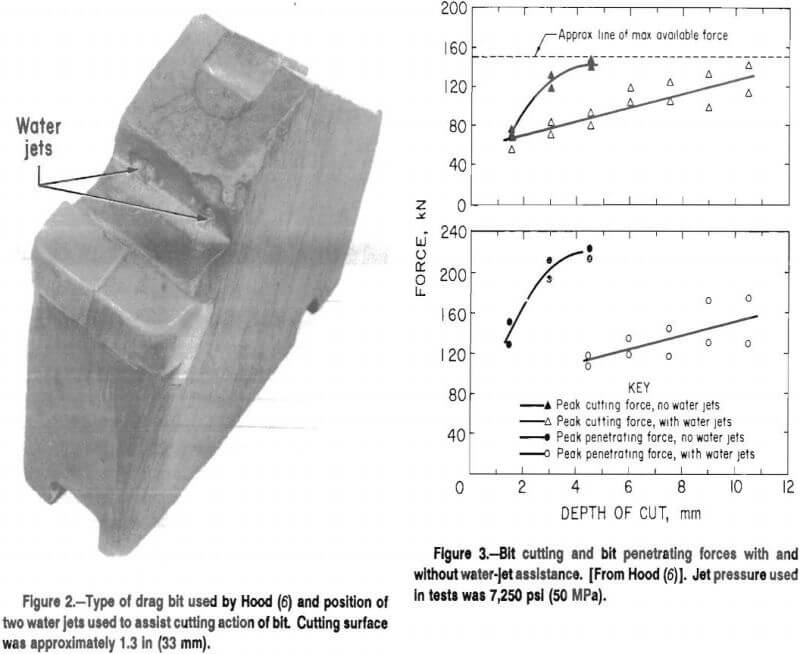
(4.5 mm). The lower bit forces realized by using the water jets increased the maximum cut depth to 0.453 in (11.5 mm) (figure 3, top).
Of equal significance, Hood (6) reported that the component of the bit force acting normal to the direction of bit travel, that is the thrust or the penetrating force, was reduced to an even greater extent than the bit cutting force (the component of the bit force in the direction of bit travel) (figure 3, bottom). The importance of this latter result is that failure of the tungsten carbide bit insert frequently is caused when an excessive penetrating force is applied to the bit. Thus, the frequency of bit failure from force overload would be expected to diminish when water jets are used to assist the cutting process. This expectation was realized during the field trials where increases in bit life of an order of magnitude were recorded.
Considerable work with jet-assisted cutting systems has been carried out over the past decade. Most of this work has employed drag bits as the cutting tools, and a wide variety in the geometry of this type of tool has been examined. Also, a wide variety of rock types has been cut in this experimental work. In general, these studies have confirmed Hood’s findings that an appropriately directed water-jet system usually can reduce the bit cutting force by a factor of at least 2, and the bit penetrating, or thrust, force, by a factor in excess of 2.
Typical results from laboratory work by Ropchan and Dubugnon are given in figures 4 and 5. The work of Ropchan is of interest because two different types of picks, chisel and point attack, were used, and the experiments were conducted directing the water jet at the rock- tool interface from a position behind the pick. Dubugnon conducted his work using a bit similar to that employed by Hood, and like Hood, he used a two-jet arrangement for the water jets with these jets directed immediately in front of the bit, toward the bit corners. However, Dubugnon used three different rock types: (1) A strong, fine-grained sandstone with a uniaxial compressive strength of 21,700 psi (150 MPa), (2) Bohus Granite with a uniaxial compressive strength of 29,000 psi (200 MPa), and (3) a tough, fine-grained, silicious limestone with a uniaxial compressive strength of 36,300 psi (250 MPa). Dubugnon found that the extent of bit force reductions caused by the jets was influenced strongly by the rock type. For example, the average bit thrust force was reduced by as much as 80 pct of the value measured when granite is cut dry, but this same force component under the same cutting conditions was reduced by only 65 pet in the sandstone. Dubugnon suggested that these different responses in these different rock types may be attributed to
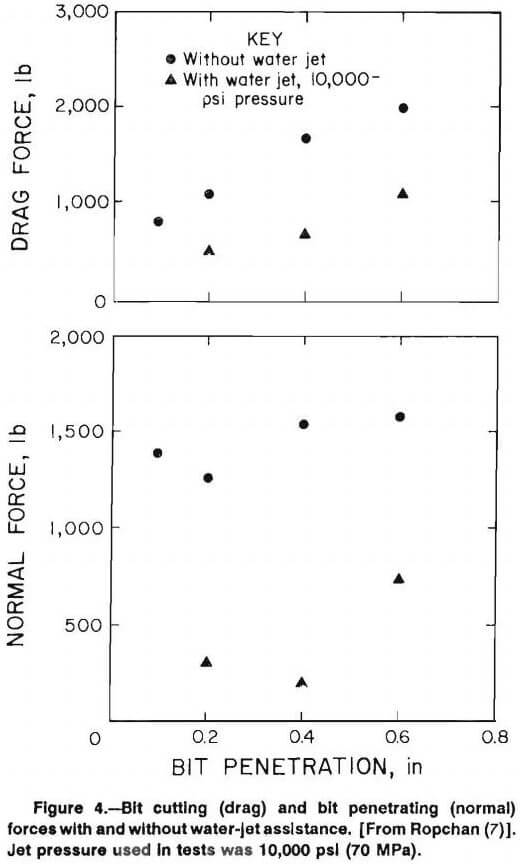
the dilatational behavior of the rock. He argued that the ability of a water jet to penetrate the rock zone adjacent to the tool is proportional to the rock dilatancy. Thus, he reasoned, rocks such as granite, which exhibit high dilatation, are more easily assisted by high-pressure water jets.
An explanation that sometimes is put forward to account for the lower values of the bit cutting force measured when water jets are used to assist the cutting process is that the jets “lubricate” the rock-bit interface. From the results presented above, it can be seen that this is not the case. Indeed, the ratio of the bit cutting force to the bit normal (penetrating) force, sometimes termed “the coefficient of cutting friction,” actually is seen to increase in the work of Hood, Ropchan, and Dubugnon. In other words, the opposite of lubrication, increased friction, is observed. An explanation for this behavior,
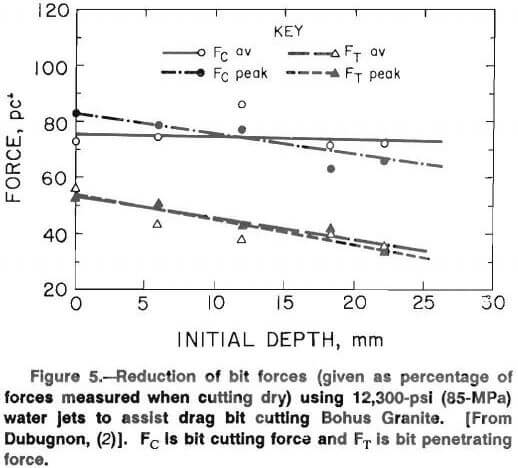
suggested by Geier, is that the cushion of crushed rock on which the bit rides when water jets are not used acts as a lubricant for the bit. When this cushion is removed by the jets, the friction coefficient between the bit and the rock increases.
The only commercial application of this technology to date has come about as a result of an extended development project undertaken collaboratively by British Coal Corp. (formerly the National Coal Board) and the Bureau. The goal of this work was to learn whether the addition of a water-jet-assisted cutting system to a roadheading machine could extend the cutting capability of this machine from weak and medium-strength rocks to strong rocks.
Laboratory experiments conducted by British Coal showed that bit cutting force was reduced by about 30 pct and the bit penetrating force was reduced by about 50 pct when 0.5-in- (12.5-mm-) deep cuts were made by a pick in a strong sandstone. The pick velocity during these tests was 225 ft/min (1.14 m/s). The initial field trials with a 10,000-psi (70-MPa) water-jet system mounted on a roadheading machine demonstrated that considerable benefits could be derived from the use of these jets. The rock cut at the trial site was, mostly, a limestone with a uniaxial compressive strength of 17,000 psi (117 MPa) and a uniaxial tensile strength of 3,040 psi (21 MPa). An interesting result from these trials is that when the water jet was not used, the cutter head encountered higher and higher resistance as it progressed on its path through the rock. Eventually this resistance exceeded the force capacity of the slew ram and the head bounced back out of the cut, unable to complete its path. When the 10,000-psi (70-MPa) water-jet system was employed, the reduced levels of the pick forces enabled the cutter head to complete its sweep through the rock, and consequently no increase in the slew ram pressure was observed.
A later field trial using a different roadheading machine is described by Morris. This work was conducted in a British coal mine where the rocks cut were a variety of coals, fire clay, shales, siltstones, and sandstones. One of the sandstones in this drivage had a uniaxial compressive strength of 24,700 psi (170 MPa). As with the previous field trial, considerable improvements in cutting performance were reported when water jets were used to assist the cutting process. These benefits included a 50-pct improvement in cutting rate and a 30-pct reduction in the mechanical specific energy (that is, not accounting for the energy input of the water jets).
Following these field experiences, two British manufacturers of roadheading machines, Dosco and Anderson Strathclyde, developed commercial versions of their machines with 10,000-psi (70-MPa) water-jet systems.
Tool Force Reductions-Importance of Jet Position
One of the findings to emerge from the research on this cutting method is the overriding importance of jet position. It is postulated that the main role of the water jets in assisting the cutting process is the removal of crushed rock adjacent to the cutting tool. Because this crushed material is concentrated in a small region, if the jets fail to strike that region, then the benefits to the cutting process are greatly reduced. Claims have been made by some workers (2-11) that the optimal jet position is in front of a drag bit, while other investigators report that the best results are obtained when a jet is directed from behind the bit.
This difference of opinion may be due to the different bit geometries used by these different workers. When the jets are directed in front of the bit and if they are to strike the target zone of crushed material consistently, then it is important that they be directed parallel to the leading face of the bit. If this requirement is not followed and the jet is directed to the bit-rock interface from some position ahead of the leading face of the bit, then as the depth of cut taken by the bit increases, at some point the jet will be deflected from its target by the intact rock ahead of the bit (fig. 6). With the geometry of bits used by Hood and Dubugnon and with the chisel-type bits used by Hood, it is not difficult to direct the jets parallel to the leading bit face. However, with the point-attack picks used by Ropchan, the problem is more complex because the bit has two cone angles, in addition to an angle of attack, and a skew angle. It is unclear with this complicated geometry how a nozzle might be mounted ahead of this type of pick in a manner that would ensure that the jet would always strike the target zone. This may
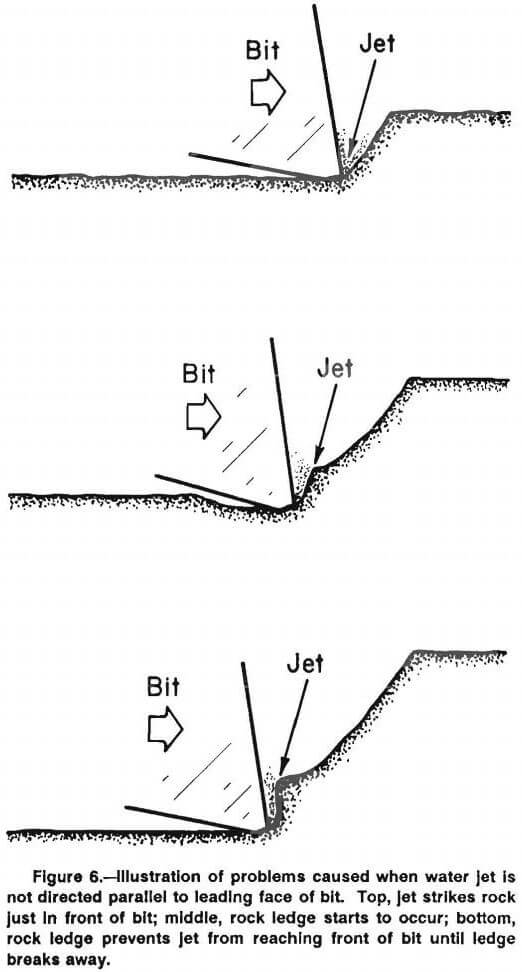
be the reason that Ropchan reported greater benefits from directing the jet toward the crushed zone formed beneath the bit from a position behind the bit.
Another worker, notably Tecen, has reported considerable benefits from the use of high-pressure water jets with point-attack picks with the jets directed ahead of the picks. However, it is clear that the author employed the jet to cut a kerf in the intact rock ahead of the advancing bit. In other words, a mechanically assisted, rather than a jet-assisted, cutting method was used. In a later paper, Fowell reported that the optimum jet position was 0.04 to 0.08 in (1 to 2 mm) ahead of the leading face of the bit [a conclusion reached previously by Hood and Dubugnon]; however, it is not clear whether this
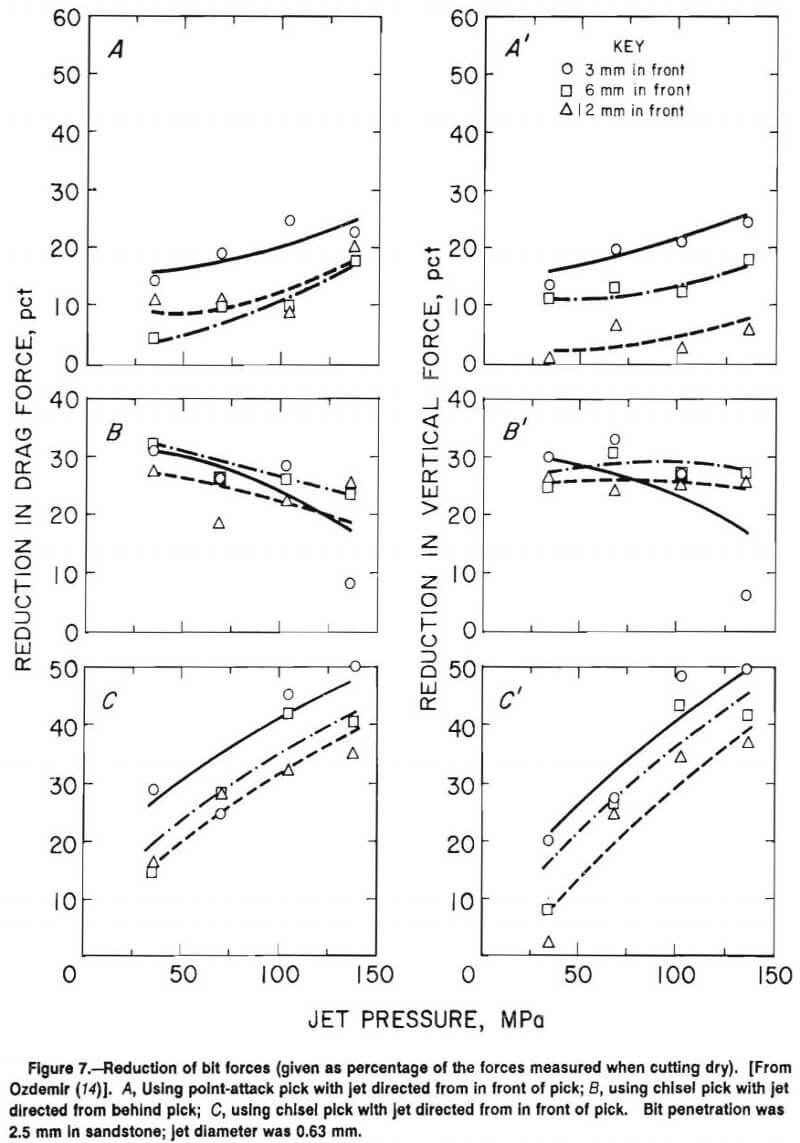
remark was made with reference to point-attack or to chisel picks.
Work examining the importance of jet position with both point-attack and chisel-type picks was conducted by Ozdemir. These experiments were carried out by cutting in a strong 18,900-psi (130-MPa) uniaxial compressive strength sandstone. The cut depth used was 0.1 in (2.5 mm), and the pick velocity was held constant at 48 ft/min (0.25 m/s). A single water jet was directed to a position on the rock surface either in front of or behind the pick during these tests. The geometry of the point-attack pick constrained the jet position to be in front of this pick, because mounting the nozzle behind it would have caused the jet to strike the pick before it impacted the rock surface. Three different points of jet impingement on the rock surface away from the point of rock-pick contact were examined: 0.12, 0.24, and 0.48 in (3, 6, and 12 mm). The diameter of the nozzle used to form this jet was 0.025 in (0.63 mm).
The results of this work showed that for the point- attack pick, the exact positioning of the jet with respect to the pick had a major influence on the extent to which the pick forces were reduced (fig. 7A). In fact, the work by Hood and Dubugnon indicates that Ozdemir might well have achieved greater force reductions if Ozdemir’s point of jet impingement had been closer than his closest point of 0.12 in (3 mm). Considerable force reductions (of the order of 30 pct) were observed when the jets were directed from behind the chisel pick (fig. 7B). It is somewhat surprising that, in this case, the magnitude of the force reductions was independent both of the point of jet impingement and of the jet pressure. Figure 7C shows again that with the jet directed in front of, in this case, the chisel pick, the greatest force reductions were measured when the jet impinged closest to the pick. It is surprising that the sizable force reductions shown in this figure were recorded with the jet aimed as far as 0.47 in (12 mm) ahead of the pick. This implies that the observed reductions in pick forces may have been caused by the jet cutting kerfs in the rock. In other words, the breakage process may have been attributable more to mechanical assistance than to jet assistance.
In summary, all of the workers who have studied this cutting method have agreed that accurate positioning of the jet with respect to the cutting tool is of crucial importance. The consensus is that, for most bit designs, the jet should be directed at the rock-bit interface no more than 0.04 to 0.08 in (1 to 2 mm) ahead of the leading face of the bit. For the reasons given above, in practice this means that the jet should be directed parallel to the leading face of the bit. An exception to this rule may be point-attack picks which, for reasons of geometry, may be assisted best by a jet directed from behind the bit.
Tool Force Reductions-Effect of Bit Velocity
The effect of bit velocity on the bit force reductions caused by water jets remains a controversial issue. Some workers have conducted experiments using drag bits at tool velocities greater than 192 ft/min (1 m/s). These workers conclude that at these high cutting speeds, the benefit of reduced bit forces decreases to the point where it becomes negligible. However, a review of the experimental technique used by these various research groups reveals that their procedures called for the measurement of bit forces with increasing tool velocity while holding all of the other test parameters, including the water-jet parameters of pressure and flow rate, constant. Obviously the potential problem with this experimental approach is that the energy deposited on the rock surface per unit cut length by the water jet decreases as the bit velocity increases. Under these circumstances, it is not too surprising that the effectiveness of the water jets in reducing the bit forces also decreases because it might be anticipated that the jet energy is reduced to the point where it becomes incapable of eroding the crushed rock material from the region adjacent to the bit.
Perhaps the most detailed investigation of pick force reductions at various pick velocities was conducted by Morris. A chisel pick with the water-jet arrangement shown in figure 8 was used. The experiments were carried out in two sandstones, whose uniaxial compressive strengths were 10,900 psi (75 MPa) and 21,800 psi (150 Mpa), respectively, and whose tensile strengths were 1,670 psi (11.5 MPa) and 3,340 psi (23 MPa), respectively. The investigator measured several parameters at three cutting speeds: 96, 173, and 257 ft/min (0.5, 0.9, and
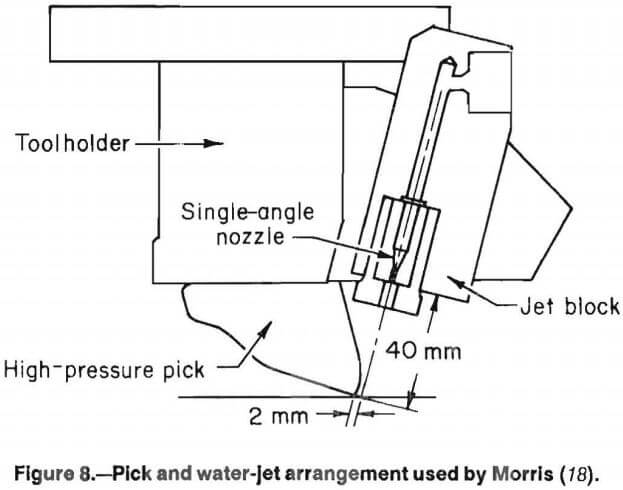
1.34 m/s). Unlike previous workers, Morris varied the jet power as the cutting speed was changed. This power was changed by varying jet pressure while holding the jet flow rate constant at 10.8 gpm (4 L/min). Five levels of jet pressure were examined: 29, 1,450, 4,350, 8,700, and 20,000 psi (0.2, 10, 30, 60, and 138 MPa); these pressures corresponded to jet power levels of 0.013, 0.90, 0.68, 5.36, and 12.33 hp (0.01, 0.67, 2, 4, and 9.2 kW), respectively. The depth of cut taken was 0.79 in (20 mm). Morris reported that, at least in the harder rock, almost no reductions in the pick forces were observed even at the highest jet pressure (fig. 9). The jet energy per unit length of cut for the experiment shown in this figure was 6.52 x 10 -5 hp·hr/in (6.9 J/mm).
Despite the potentially serious flaw in the methodology used by some of these research groups, their main conclusion that substantial force reductions are not achieved at high bit velocities seemingly was supported by the results of a field trial funded by the Bureau. Trials were carried out in coal on a longwall face using an Eickhoff shearer equipped with a 10,000-psi (70-MPa) water-jet system. The pick velocity for these tests was about 400 ft/min (2.1 m/s). The influence of using water jets was reported as negligible, both on the cutting motor load and on the haulage force of the machine along the face. However, the picks used for this trial were of the point-attack type which, as noted above, may be more difficult to assist with water jets than chisel-type picks. This, therefore, provides a possible explanation for the observed lack of significant force reductions when jets were used to assist the cutting operation. The position of the jets for these tests is shown in figure 10. Although this figure shows nozzles mounted both in front of and behind the picks, the nozzle behind is labeled as “optional” and was not used in these tests.
Another possible reason why these forces were not reduced measurably is that the jet energy available might have been insufficient to remove the crushed rock from the face adjacent to the picks. The water-jet power at a pressure of 7,250 psi (50 MPa) and a flow rate of 20.9 gpm (79 L/min) (one of the conditions tested) is about 88.5 hp (66 kW). Since 27 picks were assisted by jets, this is equivalent to 3.2 hp per pick (2.4 kW per pick) and, at a pick velocity of 400 ft/min (2.1 m/s), this yields a jet energy per unit length of cut by a pick of 1.09 x 10 -5 hp-hr/in (1.15 J/mm). This jet energy may have been inadequate to remove this crushed material even if the jet was directed accurately at the target crushed zone.
The argument that bit velocity per se should not affect the reductions in bit forces was advanced by Hood. The author argued that if the jet power was increased proportionally with the tool velocity so that the jet energy per unit length of cut remained the same, the force reductions should be preserved. The experiments were conducted by cutting in Indiana Limestone with a chisel-type pick and a single water jet directed 0.039 in (1 mm) ahead of, and parallel to, the front face of the pick. The reduction
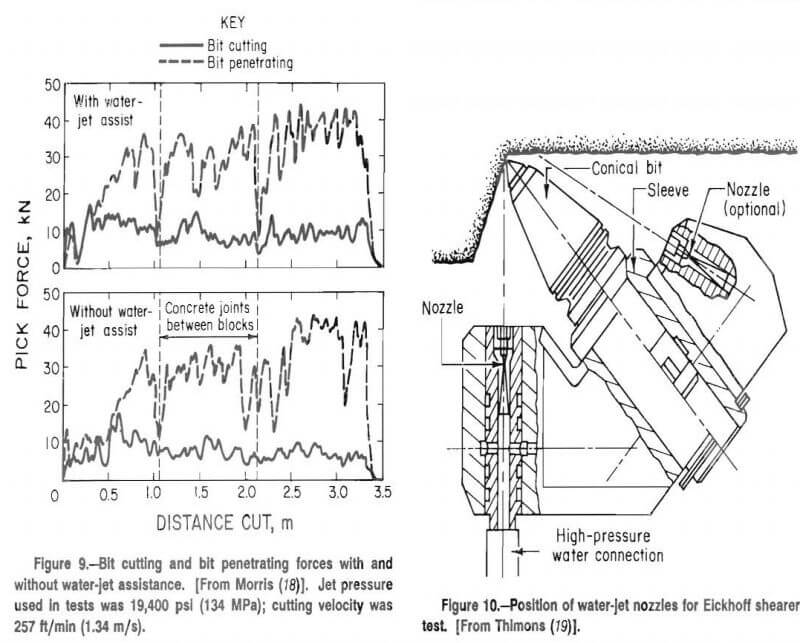
in the pick forces were measured, with respect to cuts made without any water jets, using five different jet pressures with a maximum pressure of 10,000 psi (70 MPa), three different jet nozzle diameters, and two cutting speeds. Unfortunately, the limitations of the apparatus limited the maximum cutting speed to 80 ft/min (0.42 m/s), and therefore their findings, while interesting, are not conclusive. The author found that, over the range of the parameters investigated, the reductions in bit forces were proportional to the jet energy per unit length of cut and were independent of the cutting speed. Over a range of jet energy values of nearly two orders of magnitude, from 9.46 x 10 -6 to 6.62 x 10 -4 hp·hr/in (1 to 70 J/mm), the reductions in the average pick cutting force were observed to increase slowly from about 20 to 40 pct. On the other hand, the pick normal, or penetrating, force was observed to increase roughly linearly from only about 10 pct at low jet energy values to about 70 pet at high jet energy values (fig. 11).
The importance of this result, if it can be verified at higher cutting velocities, is that it appears not to matter whether the jet energy is supplied as mostly pressure or mostly flow rate. Provided that the energy content of the jet is adequate, the bit forces will be reduced. However, it is important to note that for a number of reasons it may not be practical to supply the needed flow or pressures in underground situations.
Support for Hood and Geier’s thesis that bit force reductions should continue to be realized, even at high bit velocities provided that the jet power is increased proportionally with the bit velocity, came from another field trial using a water-jet assisted shearer. This trial
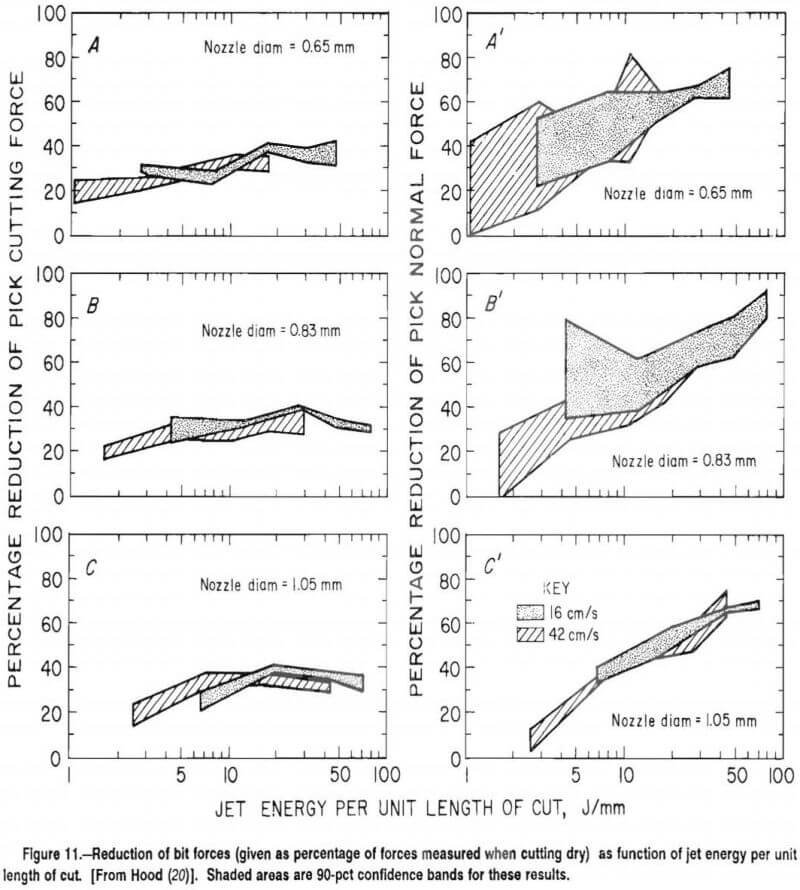
was conducted by British Coal and is described in a British Coal report to the European Communities Commission. It employed water jets to assist only those 15 picks mounted on the face (or clearance) ring of the shearer. Conventional water flushing was used for the 14 vane picks. Chisel picks were used for all cutting tools, and the water jets were directed ahead of the front faces of the clearance picks. The high-pressure pump fitted to the shearer was capable of delivering 14.5 gpm (55 L/min) at a pressure of 10,000 psi (69 MPa). The pick velocity was approximately 575 ft/min (3 m/s). Thus, the total installed hydraulic power was 84.8 hp (63.25 kW), or 5.6 hp per pick (4.2 kW per pick), and the jet energy per unit length of cut was 1.32 x 10 -5 hp-hr/in (1.4 J/mm).
The maximum depth of cut on a shearer is controlled by the haulage speed. Three different haulage speeds were investigated: 9.25, 10.82, and 14.96 ft/min (47, 55, and 76 mm/s). These speeds correspond to cut depths of 0.20, 0.23, and 0.32 in per pick (5.0, 5.9, and 8.1 mm per pick), respectively. It was observed that the water jets reduced substantially the power consumed by the drum; this is equivalent to stating that the pick cutting force was reduced. It was stated in the report that this finding could be significant, because it could be used as a method to extend the life of the gearhead.
One of the key parameters measured during these experiments was the machine haulage force; this is equivalent to the pick thrust, or penetrating, force. Although considerable scatter was observed in the measurements of this haulage force, it was found that the average value of the force decreased markedly with increasing jet pressure. A typical result is illustrated in figure 12. Perhaps the most convincing piece of evidence regarding the effectiveness of the water jets at this high pick velocity is the observation in the report by British Coal that when water jets were not used to assist the cutting process, the shearer stalled continually at the highest haulage speed of 14.96 ft/min (76 mm/s). However, using the water-jet system, the machine cut smoothly along the face with no stalls. Thus, this report concludes “for all practical purposes, the maximum cutting speed of the machine was substantially increased when high-pressure water aided.”
Reduction of Dust Frictional Sparking and Machine Vibration
All of these parameters are difficult, or impossible, to measure in the laboratory. Consequently, this section describes results from field trials.
Although the dictionary definition of dust includes all fine particles, a health hazard is presented only by those
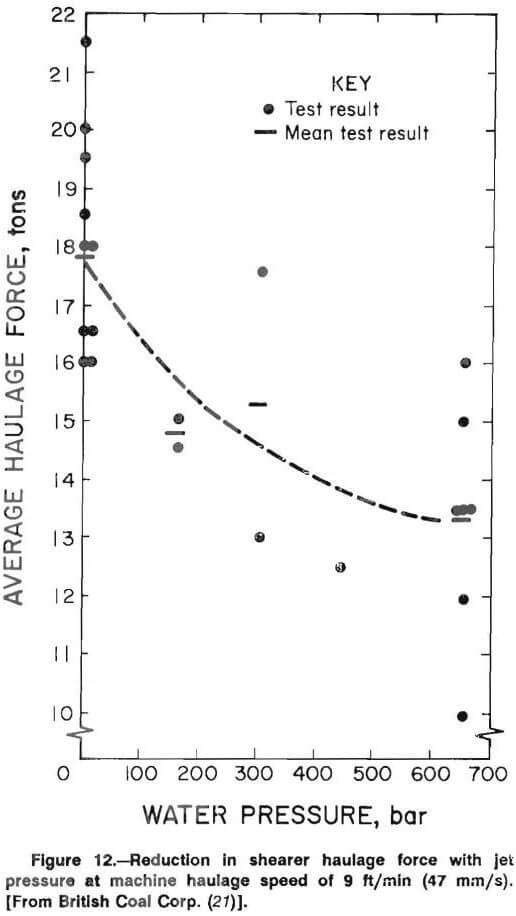
particles that become airborne. Hence, mining engineers tend to apply the term “dust” only to these airborne fine particles, and this is the sense in which this term is used here.
The results of all of the field trials reported in the literature are unanimous in proclaiming that dramatic reductions in dust production are realized when water jets are directed immediately adjacent to the cutting tools. Although his results were not quantified, Tomlin, at the first field trial with a water-jet-assisted roadheader, observed that the use of the high-pressure water jets at 5,950 to 10,000 psi (41 to 70 MPa) caused considerable reductions in the dust produced by the cutter head, compared with conventional dust suppression sprays, as discussed in the British Coal report. It is noted also in this report that the incidence of frictional sparking was very high when cutting operations were carried out in sandstone using only conventional dust sprays. This problem was apparently eliminated completely by using the high-pressure water-jet assisted system.
Measurements made during later trials with roadheaders showed that dust levels were maintained consistently below 2 mg/m³ provided that the jet-assisted cutting system was employed. These authors note that substantial reductions in dust were observed at jet pressures well below the maximum 10,000 psi (70 MPa) available, although in another paper, apparently describing this same field trial, a curve was given indicating that dust quantities are strongly influenced by the water-jet pressure (fig. 13). Again, corroborating previous findings, frictional sparking was not observed during these trials when the water-jet-assisted cutting system was used. A marked reduction in machine vibration was also observed as illustrated by the lower frequency content of that portion of the curve in figure 14 that represents the cutter head power when water jets were used to assist the cutting process.
Currently, some 16 roadheading machines with high-pressure water-jet systems are operating in the Cape Breton coal mines in Canada. The rocks cut by these machines are relatively soft, principally coal. Perhaps because the strata are not hard, the principal benefit of using water jets on these machines has been found to be dust suppression. A study to examine the effectiveness of the water jets on these machines found that the dust levels decreased rapidly as the jet pressure increased, up to a jet pressure of 4,350 psi (30 MPa). Beyond this value of jet pressure, the dust level started to increase.
In the shearer trial with the Eickhoff machine, the principal benefit of using water jets was again found to be a substantial reduction in the dust generated during the cutting operation. Figure 15 shows dust measurements on this shearer coal face both for conventional cutting and for cutting using the water-jet system; it is apparent that a 70- to 80-pct reduction in dust at the face was observed. Confirming the finding of previous workers, these authors discovered that substantial reductions in dust quantities were observed even at low water-jet pressures of 1,800 psi (12.4 MPa). Increasing the jet pressures to 7,250 psi (50 MPa) did not produce any further substantial reductions in the measured dust loads.
Similar findings were reported for the British shearer field trial, although in these tests some slight improvement in measurable dust concentration with increasing jet pressure was observed (fig. 16). The question of the influence of the water jets on the vibration of the shearer was addressed, but was not answered satisfactorily, during these trials. Apparently, the machine operators were of the opinion that the water jets caused the shearer to function more smoothly. However, when accelerometers were fitted to the machine, it was found that somewhat higher acceleration levels were measured when the water jets were in use. The authors of the report concluded that, at least in this situation, no reduction in machine vibration took place.
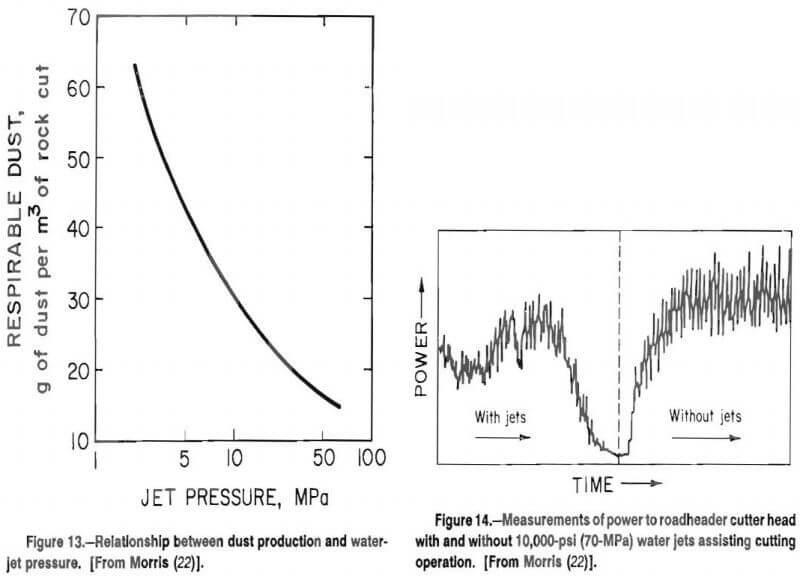
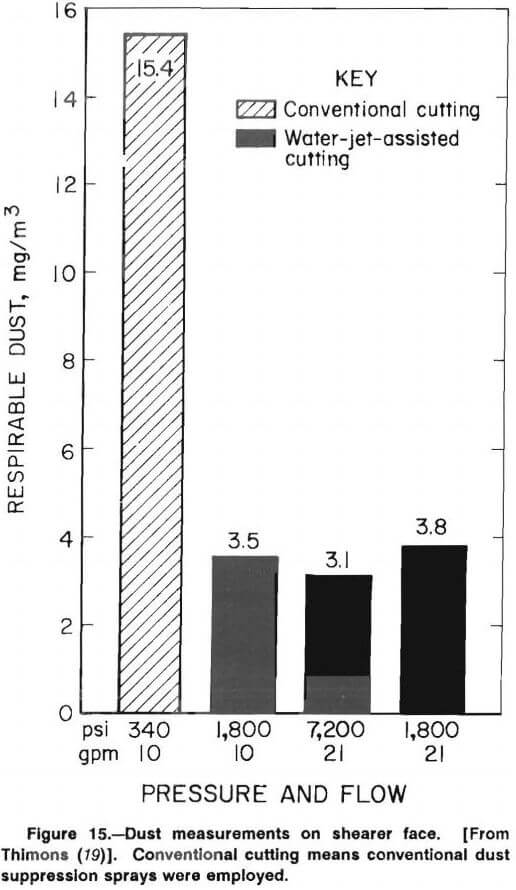
Reduction in Bit Wear
The rate of bit wear is related directly to excessive bit temperatures. Hood measured the temperatures generated in the bit body during the cutting operation, both with and without water jets. He showed that the bit temperatures were reduced substantially (by several hundred degrees Celsius) when jets were used. This result implies that jet-assisted cutting should result in greatly reduced bit wear rates. This expectation was realized in the underground tests where improvements in bit life, often by more than an order of magnitude, were achieved.
Measurements of bit temperatures also were made by Nienhaus. The results (fig. 17) show that bit temperatures increase with cut length. This finding, at first glance, appears to contradict the observation by Hood, who showed that bit temperatures rose rapidly from room temperature to a maximum value and then stabilized at that value. This maximum temperature was attained within the first few centimeters of the cut. However, reflection on these findings reveals that no contradiction exists. Hood’s work was carried out making short cuts of the order of 9.6 ft (3 m) in a nonabrasive rocktype. Consequently, little wear of the bit took place during his experiments. On the other hand, it is extremely likely that measurable wear of the bit(s) used in the experiments by Nienhaus took place during cuts of as much as 6,560 ft (2 km) of artificial rock cut length (fig. 17). Any increase in the bit wear flat will result in an increase in the bit temperature at a given bit velocity. Thus, it is very likely that the increasing slopes of the curves shown in figure 17 are manifestations of the continuing increase in the wear flats of these bits.
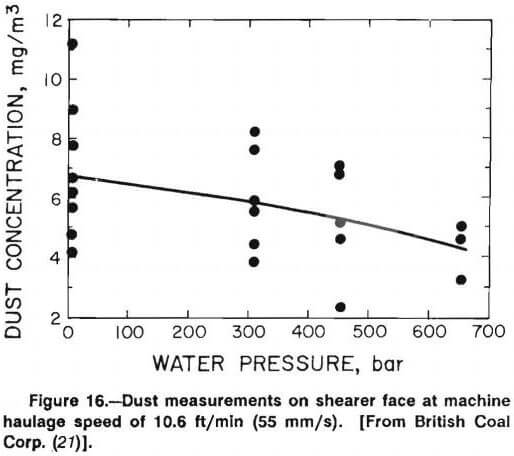
The two upper curves in figure 17 show that much higher bit temperatures were recorded when the cutting velocity was doubled from 192 to 384 ft/min (1 to 2 m/s). This result accords with the theory presented by Cook. It can be seen from this figure that, at both of these bit velocities, the temperatures were reduced by a factor of about 3 when water jets, at a jet pressure of 6,500 psi (45 MPa), were used to assist the cutting process. Perhaps of greatest interest is that the gradients of the lower curves, which represent the bit temperatures using the water jets, are less throughout this domain than those of the upper curves that represent dry cuts. Following the argument in the preceding paragraph, this probably indicates that the rate of bit wear is significantly less
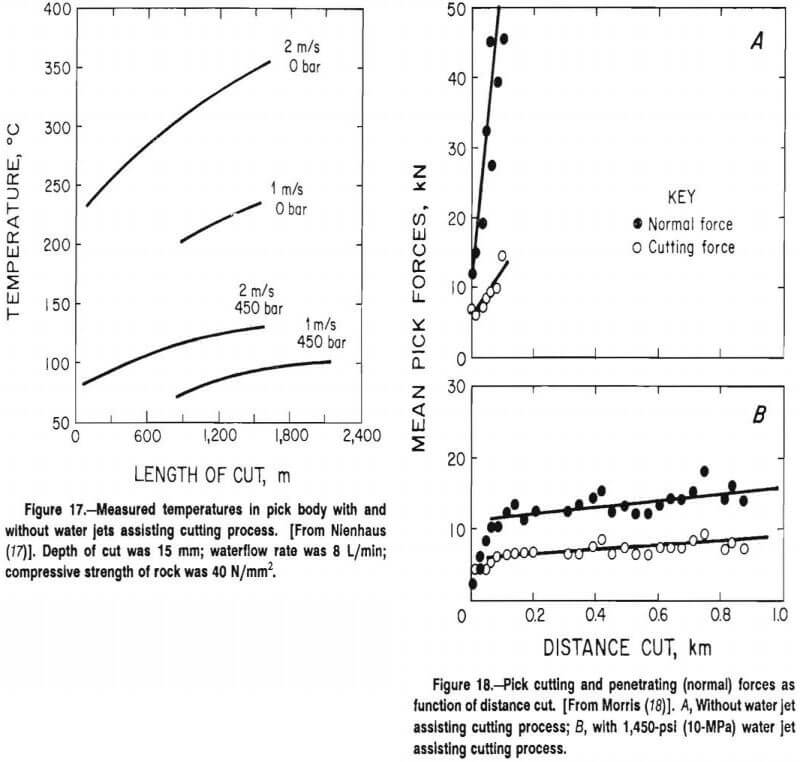
when the jets are employed. Furthermore, these lower curves appear to level out, indicating that bit wear may not increase beyond the amount caused by cutting a distance of 4,900 to 6,900 ft (1.5 to 2.1 km) in this artificial rock. In other words, when water jets are used, the bit wears from its new condition to some point, but it does not wear, at least not substantially, beyond that point. This finding, if true, is very significant. This study was done with a chisel bit which, as noted above, may be assisted with jets more easily than a point-attack pick. It would be interesting to measure the cooling effect of water jets using point-attack picks.
The benefits to be derived from the cooling effect of the water jets when these jets are directed immediately adjacent to the bits was pursued in the study by Morris. It was shown that even in situations when a jet, properly mounted with respect to the bit (see figure 8), was incapable of effecting significant reductions to the bit forces, presumably because the jet energy was insufficient to remove the crushed material from the region adjacent to the bit, major long-term benefits were realized. Results published by Morris are given in figure 18. Figure 18A shows the measured increases in the bit cutting and in the bit normal forces as a function of the distance cut. The steep slopes of these curves obviously is caused by the rapid blunting of the bit when water jets are not used to assist the cutting process; eventually these loads become so great that the tungsten carbide insert shatters. Figure 18B is a similar plot; only in this case a relatively low-pressure, 1,450-psi (10-MPa), water jet was used to assist the breakage operation. It is apparent that the rate of blunting of the bit, as indicated by the slopes of these curves, is much less than for the previous case. Morris concluded that one of the most important effects of water jets that are directed adjacent to drag bits to assist the cutting operation is to provide effective cooling of the bits which, in turn, preserves the tool sharpness.
This prediction that water-jet-assisted cutting can improve bit life has been confirmed many times in the field. The initial roadheader field trial report commented that significant improvements in pick life were achieved by using the water-jet system. Morris reported that “pick consumption (when using water jets to assist the cutting process) was very low, less than one pick per metre of advance.” A dramatic test was conducted to show how effective the water jets were in extending bit life. For this test, the nozzle orifice to 2 of the 24 picks on the cutter head was blocked. The machine then was used to advance the tunnel by 1 m. During this cutting period, it was necessary to change 1 of the picks without a water jet 23 times and the other pick without a jet had to be changed twice. Only 1 of the remaining 22 picks, which were assisted by water jets, needed to be changed.
Disc Cutter Force Reductions
Fenn conducted an experimental program in the laboratory to determine whether water jets could be used to reduce disc cutter forces. The work was carried out by cutting norite, a strong, but nonabrasive rock, with a 36,800-psi (254-MPa) uniaxial compressive strength and a 1,725-psi (11.9-MPa) tensile strength. The work demonstrated that, with appropriately arranged jets, significant force reductions were observed. Four jets, two directed from each side of the cutter, were found to yield the best results. Jet pressures up to 23,200 psi (40 MPa) were employed. The diameter of the nozzles used was 0.047 in (1.2 mm). Typical results are shown in figure 19. It can be seen that substantial reductions in both thrust and rolling forces were measured when the water jets were employed.
Few attempts have been made to employ water-jet systems to assist roller cutters in the field. One experiment reported in the literature by Marlowe used a blind-hole borer cutter head fitted with two row button cutters. The jets, in this case, were mounted not on the sides of the cutter as recommended by Fenn, but on the ends so that the jets either led or lagged the cutters. The jet pressure used for these tests was of the order of 4,350 psi (30 MPa). No substantial benefits were reported from the use of this jet system.
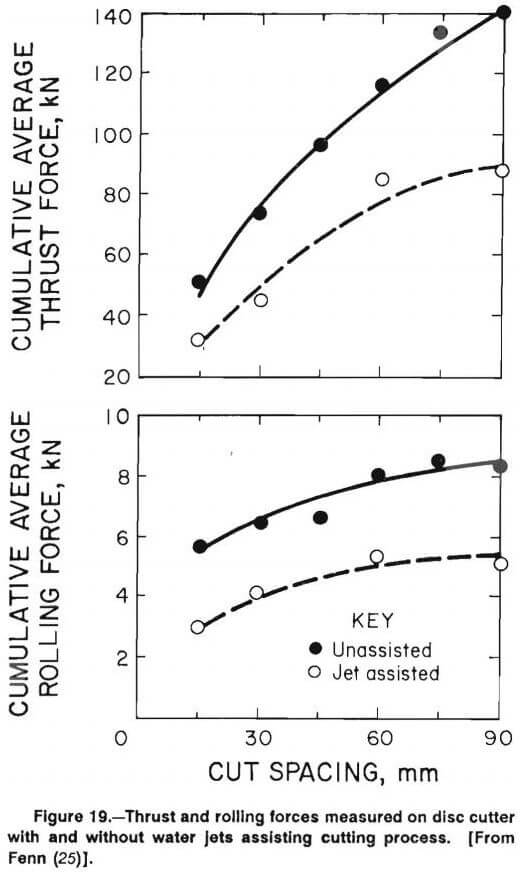
Conclusions
Substantial reductions in tool forces can be achieved when high-pressure water jets are directed in the immediate vicinity of a mechanical rock cutting tool. In addition to reducing these forces, these jets also are effective in cooling the tool during the cutting operation. These two factors of lower forces and cooler tools result in substantial improvements in tool life. Other advantages claimed for this cutting method include significant reductions in the dust and in the incidences of frictional sparking and less machine vibration.
Some investigators question whether some of these benefits, particularly the reductions in tool forces, can be achieved under the practical constraints of high tool velocities and deep cuts that are experienced with mining and tunneling machines. Other workers argue that if sufficient attention is paid to directing the jets into the region of crushed rock adjacent to the tool and if the jet energy is sufficient to erode this crushed material, the tool force reductions will be preserved, even at high tool velocities. More work is needed to resolve these questions. On the other hand, Morris has shown that, even if the cutting conditions are arranged so that tool forces are not reduced significantly by the jets when the tools are sharp, the cooling effect of the jets substantially retards the blunting process and therefore lower tool forces are experienced because the cutting operation is carried out with sharp tools.
Other benefits, such as dust and spark suppression, are widely accepted, and it has been found that these benefits can be achieved at low jet pressures of the order of 2,900 to 4,350 psi (23 to 30 MPa).
This cutting method has the potential for achieving a major advance in rock breaking. This potential is only now starting to be realized. The method reduces the mechanical tool loads; this is true over time and it may or may not be the case when the tools are new. It also reduces the thermal tool loads. These benefits give excavation machines the capability of cutting in stronger rock than can be machined when water jets are not employed. Alternatively, the lower tool forces give machines the capability for higher rates of excavation than are possible without jets. Finally, because the water-jet system is compact and because the use of this system results in lower forces at the cutter head, the equipment size needed for a given rate of rock excavation might be reduced by using a water-jet-assisted cutting machine. In underground operations, small, maneuverable machines with a capability of cutting hard rock could find widespread application.
In other applications, for example coal mining, the benefits of dust and spark suppression might be sufficient to justify the installation of a water-jet system on the excavation equipment.
